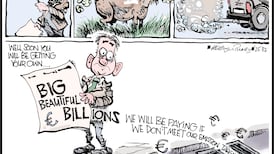For a few years now, I’ve been tracking the rents of nouveau-bedsits in Dublin. “Studio apartments”, as they’re listed, have changed. When legislation banning bedsits was introduced in 2009, and came into force in 2013, they went off the radar. Once upon a time, bedsits were basic, often veered towards grimy, and were certainly small. But they were also cheap. Today, they have returned as premium profit-making vehicles for landlords, both corporate and individual. If anything, there’s probably more money to be made per square metre in “studio apartments” than most other property.
I’ve watched the rent spiral upward for one-room quasi-homes on the North Circular Road in Dublin, from €700 a month, to €800, to €1,000, to €1,500. Now it’s €2,120 for a “studio” in Cabra, Dublin 7, in a new development, Hamilton Gardens. That particular flat isn’t too shabby. There’s a couch, a coffee table, a neat-looking kitchen and a double bed. Obviously, paying €2,120 for a “studio” is ridiculous, but what’s more worrying, is what’s happening in older buildings.
In 2015, Alan Kelly, then minister for housing, said reducing apartment sizes by 27 per cent – his developer-friendly pitch with new guidelines – would make homes “more affordable”. It certainly made them more affordable for developers to build given the extra profits they could subsequently squeeze out of developments. Kelly said smaller flats wouldn’t reduce living standards. He claimed these smaller living quarters would be cheap. The market, you see.
“A studio apartment is a one-room dwelling and this will be reflected in the price,” Kelly said at the time, defending the retrograde move. “The shoebox living of the past will not return.” He was wrong. Very wrong. At the time, plenty of experts expressed serious concerns about reducing the space in which people were expected to live. It’ is important to note these guidelines applied to new builds. As for existing buildings, it appears you can get away with anything.
READ MORE
I recently came across a “studio” in Dublin 8 renting for €550 a week. Yes, a week. This is what not too long ago one could expect to pay a month for such a tiny place. It is much smaller than the new-build in Cabra, about the size of a hotel room. That’s €28,600 a year to live in a box. What’s going on?
[ Una Mullally: This will be the year of Fine Gael’s phoney epiphaniesOpens in new window ]
Revisiting the debate around Kelly’s guidelines in 2015, I was struck by housing lecturer Lorcan Sirr’s remarks at the time, “You don’t live in 50sq m – you exist”. Later, a successor of Kelly’s as minister for housing, Eoghan Murphy, defended ludicrous “co-living” spaces at 16sq m, and characterised them as “very trendy”. It’s like a boutique hotel, he said, as if one’s home should embody the type of fleeting temporality of a mini-break.
This remark is infamous, and still highlights the idiocy at the heart of Fine Gael’s housing disaster. This guff gave landlords and developers an insidious license to reimagine housing as an impermanent thing, a place not to live in, but to float or languish for a moment.

One thing these nouveau-bedsits have in common is an almost identical aesthetic. With co-living mired in bad press, it appears landlords and developers sought to segment its concept and pepper it throughout existing buildings. When Murphy’s stupid co-living plans had to be reversed, the co-living mood bloomed elsewhere, in corners of period buildings, in the white elephants of unaffordable purpose-built student accommodation, in former bedsits made cookie-cutter-modern, in the flatlands of Dublin 7, Dublin 8, and Dublin 1.
[ Una Mullally: Why has street life in Dublin city become so depressing? Opens in new window ]
In these places, character must be erased lest it tell a story. A sense of place must be rinsed until what emerges from the white walls is what Kyle Chayka labelled “AirSpace” – “a profusion of symbols of comfort and quality” – the triumph of the generic, the homogenous. This is the Airbnb aesthetic – after all, one of their main headquarters is in the Irish capital, and Airbnb’s proliferation in Dublin has done untold damage to the rental market. As Chayka wrote in his famous article in The Verge in 2016, “The interchangeability, ceaseless movement, and symbolic blankness that was once the hallmark of hotels and airports, qualities that led the French anthropologist Marc Augé to define them in 1991 as ‘non-places’, had leaked into the rest of life.”
On rental websites, you’ll find nouveau-bedsits for two-week to three-month leases, as well as for a year. It appears that instead of new short-term let regulations bouncing accommodation back on to the long-term rental market with a fair price, a premium is still being charged.
So here we are: €2,200 a month for a bedsit – sorry, not a bedsit, we got rid of those. This is something else. A new grimness pretending to be cute. A pretty holding pen. An Insta-cell.
Expecting people to pay more than two grand a month for a shoebox is frankly offensive. Is it any wonder there is a sort of social depression hanging over Dublin city? Is it any surprise people are so angry, so deflated, so driven to the edge? What can the Government expect but rage when people are so squeezed, so demeaned and so curtailed, the walls closing in on their quality of life?














